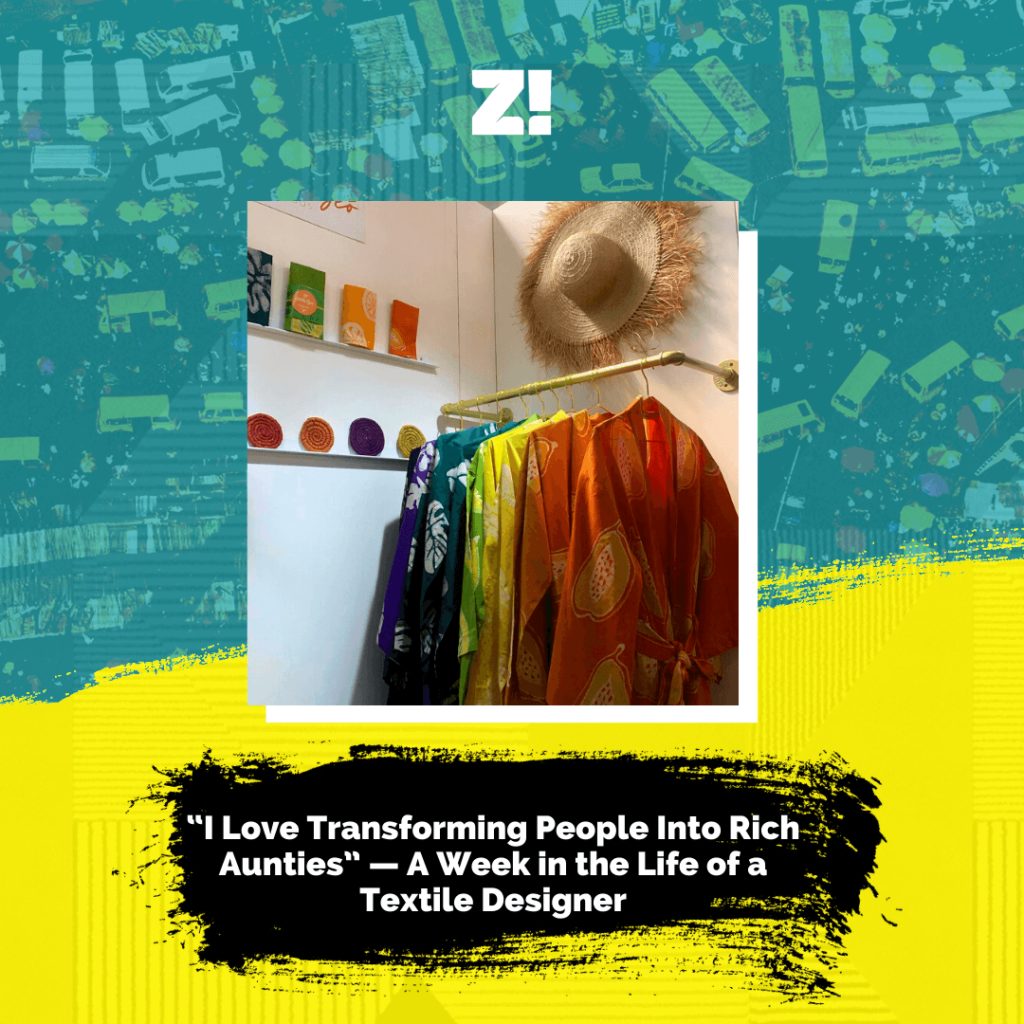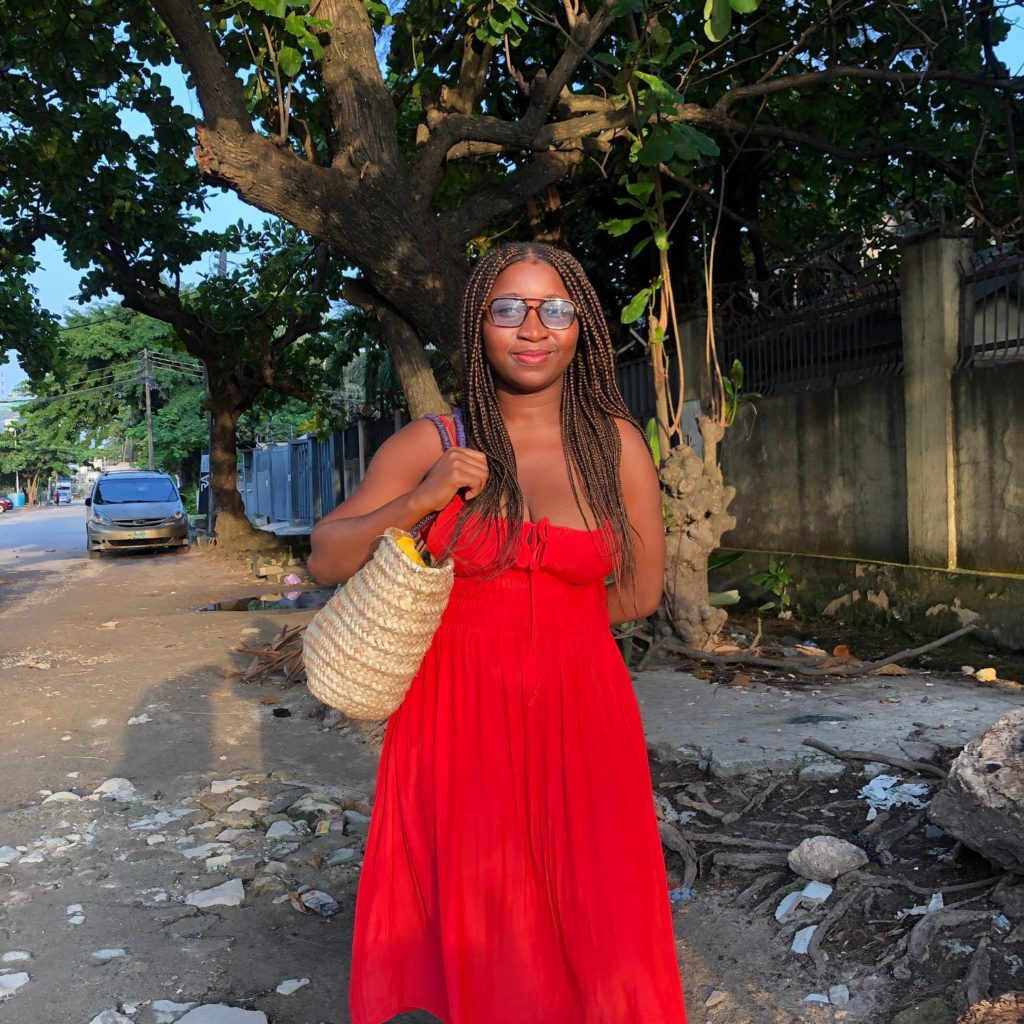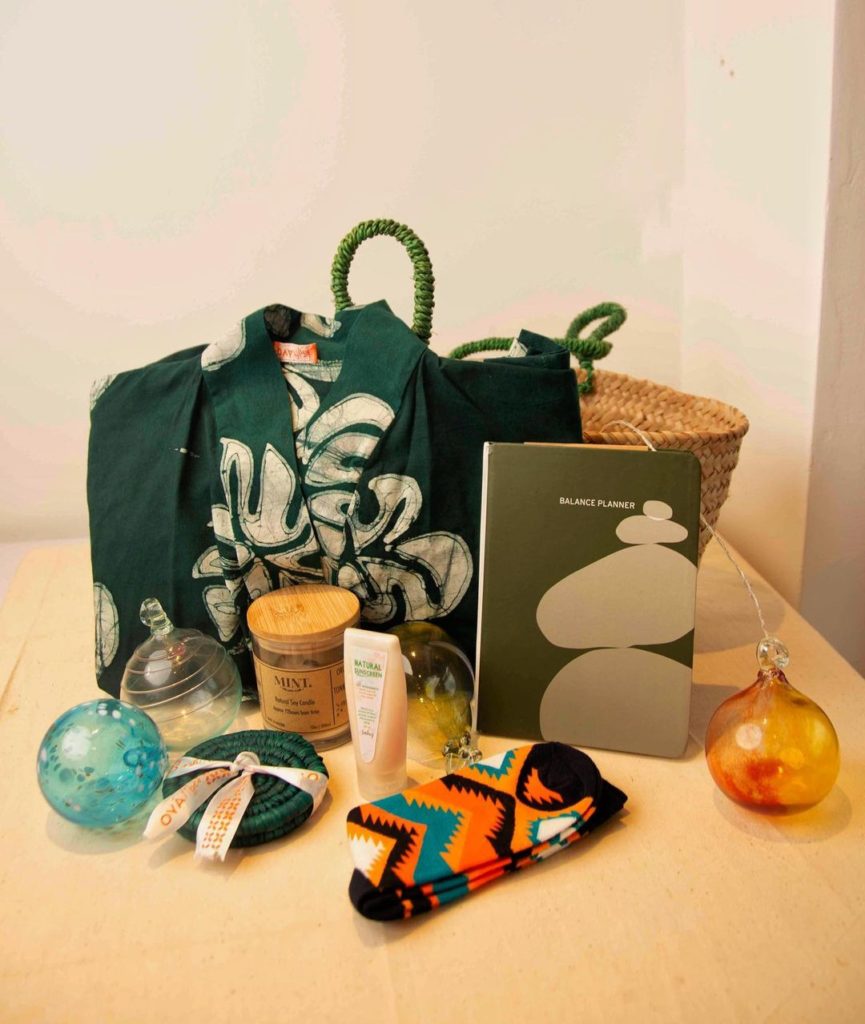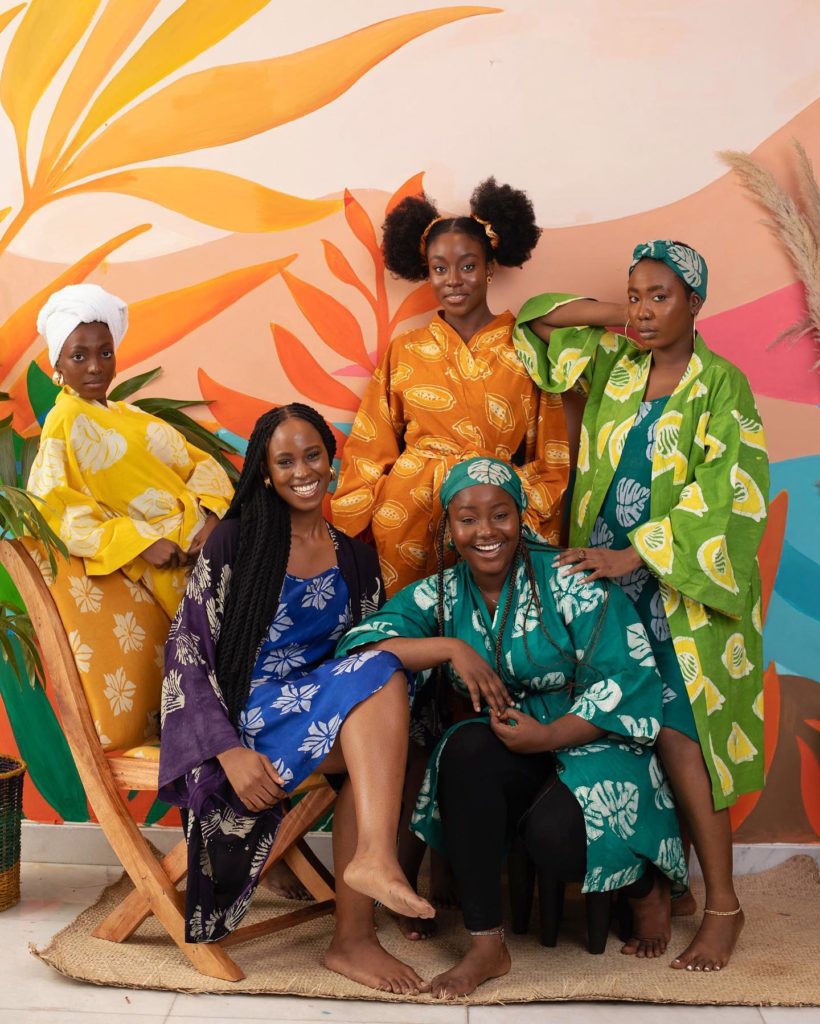A Week in the Life is a weekly Zikoko series that explores the working-class struggles and victories of Nigerians. It captures the very spirit of what it means to hustle in Nigeria and puts you in the shoes of the subject for a week.
On today’s #AWeekInTheLife, we feature Samiat Salami, who designs textile prints which she uses to make ready-to-wear clothes and home decor. She walks us through her design process, the pains of running a global business in Nigeria and how difficult it is to find plus-size models for her robes.

MONDAY
I’m not an early riser because I wake up multiple times during the night, so I usually get out of bed at 9 a.m. Because I have asthma and tend to wake up with a sore throat thanks to the air conditioner (AC), the first thing I do is have a cup of tea to help me clear my sinuses.
I try not to open my phone or computer first thing in the morning because if I do, anxiety will kick in, and I’ll get caught up in the slog of it all for the rest of the day. So while enjoying my beverage, I like to live in the moment for a bit; I can read a chapter of fiction on my toilet seat or mosey around the house.
By 10 a.m., I finally switch my phone on. And the minute I do that, it’s an avalanche that never ends, back-to-back calls or emails or whatever else I need to catch up on.
As a textile designer, I work with many artisans, and it’s a lot of stress! I get so many calls from people going, “We’ve run out of blah blah blah”, “Did you really want it this way?” and “Because we did it this way the last time and you didn’t like it, we thought we have to ask you specifically before…” Yeah, there’s just a whole bunch of back-and-forths.
I also work with manufacturers who sew my designs into actual products. So I’ll need to give and receive feedback from them as well. Then, I have to work with retailers I sell my stuff to in the US, and they would usually have follow-up questions. I also do a healthy amount of customer service following up with direct online orders and on social media.
Around 1 p.m., my team members come to my house where the living room doubles as my studio, where all the following-up comes to a head. All the “Do we like this print?” “Do we not?” “Will this print be better for robes or tableware?” “Do we need to talk about different marketing ideas?” “Do we need to shoot a campaign?” “Are we planning for this?” questions get answered from 1 – 6 or 7 p.m. We just go ham and it’s pretty intense. The day tends to be very fast-paced, but we make sure to take short breaks for lunch and to catch our breaths.
By 6 p.m., I’m hammered and restless. So when everybody leaves, all I want to do is go for a walk around my estate. I have a restless body that’s always trying to keep up with my mind and walking helps me catch up. When I get back, I just collapse into bed.

TUESDAY
My process of designing textiles begins with prints and patterns. I’m inspired a lot by the flora and fauna of Nigeria, and I do a lot of research for each collection, about the origin of a plant, how it falls, what it’s like, the colours… I often take long walks in nature, taking loads of pictures of flowers and other beautiful things I see. I curate all these photos into a mood board. Then I work with my illustrator to refine them.
For example, for the hibiscus prints I’ve been working on for months, it was just me taking loads of different species of hibiscuses I’ve seen in nature. I took pictures in Nigeria, and in California and Florida. After photographing, I’ll study the patterns, like how they go from red to yellow, for example.
Next, I work with my illustrator to create digital designs inspired by my mood board. Then we’ll send them to a really lovely man in Osogbo with whom I like to work, and fabrics for him to hand-draw the patterns on — he has to translate our illustrations into something that’s a lot more illustrative by hand. When he’s done creating the sample prints, we’ll go through several iterations until we get it right.

WEDNESDAY
I only meet my team about three times a week, so when I’m not having anyone come around my apartment, like today, I’m running around Lagos.
After catching up on emails and correspondence at around 12 p.m., I head out to Surulere or Lekki where my manufacturers operate, to approve things and discuss samples and finer details of new products.
For example, if I’m doing a fit test — putting a garment on a fit model — I’ll have to make different iterations to get it right, and that can take a whole day because it involves a lot of back-and-forths. It’s like: “cut it”, “put it on”, “twist it this way”, “put it back on”, and so on…
I use myself a lot, which is interesting because I’m not the typical fit model. I have very small body parts, and I’m only five-two. When people think of models, they’re typically tall and slender and have no curves. But that doesn’t translate into the body of many Nigerian women. This is why so many people struggle with traditional brands.
For me, I’m smallish, and I have thighs and boobs, and all sorts of things that aren’t straight, so I need to know how the clothes fit me so I can translate how it would fit other body types. This is why I’m size-inclusive. One of the reasons I started my brand is that I got frustrated struggling to find clothes that fit me.
So now, I make clothes for people of different sizes: people who are larger, people who are thinner, people who are top-heavy or bottom-heavy, etc. I want everybody to feel comfortable and safe and happy in my clothes. I don’t want anyone to have to feel like they’re conforming to any standard of beauty I’m setting. This is not about me. It’s about you feeling fucking great in whatever I make for you.
But it’s been really difficult for me to find models above a certain size, and I don’t think it’s because we don’t have women like that. Such women shy away from that industry because they’re often told that they’re not the ideal of beauty. There are cultures that find only thin people attractive, but that’s not Nigerian. I’m currently on the lookout for bigger models.

THURSDAY
One of the most frustrating parts of my work is that the manufacturing industry in Nigeria doesn’t have a solid structure yet. Countries like India, Indonesia, Morocco and Mexico, all have long histories of artisanship that have been vetted and worked with other countries. There are whole brands, American and British, that go to places like India to mass-manufacture. These countries already have legacy systems in place for everything. We don’t have that yet in Nigeria; we don’t have working production systems, so it’s difficult to get things done.
So I find myself having to build everything from the ground. It’s gruelling, but it’s me that chose this life.
Because of this, problems come up all the time in manufacturing. For instance, I only work with 100% Nigerian cotton, like Funtua. Funtua is not the kind of thing I can just go to the market in Lagos and buy because I manufacture in such large quantities, so I buy thousands of yards at a time. I get it from Kano. And now, there are problems like insecurity and terrorism plaguing that area, so these materials are becoming increasingly difficult to get.
My suppliers can just increase their prices in a blink of an eye because of all the inflation and uncertainty. Imagine how much this affects my estimates and budgets. Things like this affect production and delivery to customers. I’m not really good with sloppy work, and my perfectionist self has to deal with all these variables. It’s so tiring.

FRIDAY
Today, I received satisfactory feedback from a client. It’s the best thing in the world for me. I love that twinkle in their eyes when they try something on and go, “I look fabulous”. Especially the robes, as they tend to have a kind of decadent feel so every time someone puts them on, I can see their demeanour change. They take on this kind of rich aunty or uncle vibes, and I’m just like, “I’m here for it!”
Seeing people love something I made, after all the labour, brings me unspeakable joy. It’s especially fulfilling because my designs don’t always translate properly to print. So when we finally get it right and people fuck with it, that “oh, I made a beautiful thing” feeling washes over me.

SATURDAY
I went to Ibadan with my team today. I’ve always had this fascination with the city. As a child, one of my many ambitions was to study Yoruba and teach at the University of Ibadan (UI). Ibadan is one of those cities where the myth of it is so rich and so closely tied to what it means to be Yoruba. It has hills and red sand, a rustic feel and a certain kind of magic you can’t find in Lagos. Ife is another such city.
The last time I visited Ibadan, I knew I wanted to shoot a campaign there. So when we got into Ibadan today by train, we went straight to Amala Skye in Bodija to get our amala fix. Mehn, I ate the best ogunfe I’ve ever had. Then, we lodged at the International Institute of Tropical Agriculture (IITA) at Moniya.
I’m excited about this campaign because I’m working with an all-women team. I love when I get to work with women. The energy is always different. I like working with men too, but working with a bunch of creative women in the same room? The energy is kind of magnetic and beautiful. We’ll continue shooting in choice locations around the city for the next few days, and I can’t wait for all the beauty that’ll come out of this project.
READ ALSO: A Week in the Life of an Instagram Thrift Vendor
Check back every Tuesday by 9 a.m. for more “A Week in the Life” goodness, and if you would like to be featured or you know anyone who fits the profile, fill out this form.

